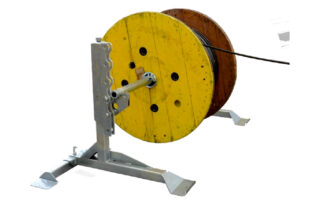The construction of an overhead line project requires the proper selection of supporting structures, fittings, and conductors. However, one must not forget about protection against electric shock. Designing an appropriate grounding system is essential for the safe operation of overhead lines.
Basics of Grounding Overhead Conductors
The type of grounding and the need for its installation depend on the design of the overhead line, the type of poles, and the location of the installation.
Overhead conductors are mounted on supporting structures, which can serve as grounding elements. Even if they are made of conductive materials, their foundations act as grounding systems. However, this requires careful analysis, as the overhead line may still need additional grounding. Conversely, grounding does not need to be designed if the supporting structures are made of non-conductive materials.
Safety must always come first, which is why, during the construction of cable lines, tools such as
cable drum lifters
are used to help workers transport heavy cable reels. In the case of overhead cables, safety must be ensured primarily by keeping the step and touch voltage below the maximum permissible levels. The grounding system consists of grounding electrodes with grounding or equipotential conductors (possibly without them). If lightning protection wires are installed along the entire length of the line, the impedance (the relationship between current and voltage in an AC circuit) must be determined while considering the influence of supporting structures and, of course, the lightning protection wires.
Where Grounding of Overhead Lines Is Required
It is obvious that safety must be ensured in publicly accessible locations. This particularly concerns places where people stay for at least a few hours a day, appear for several weeks a year, or stay for short but frequent periods. The priority is to appropriately protect
overhead cables near houses, playgrounds, or schools. In some cases, additional protection is also necessary. If a specific place is regularly frequented and the overhead line is not equipped with protective automation, it is necessary to use a ring (encircling) grounding electrode. It provides additional protection alongside a vertical grounding electrode.
Poles of overhead lines are often located near heavily used buildings: houses, public institutions, sports facilities, or roads. Therefore, it is necessary to comply with permissible touch-voltage values. If these values are exceeded near grounding electrodes, additional protections are required. These may include ring equipotential grounding electrodes or electro-insulating layers placed on the ground. Another option is to create barriers that restrict access to places where the touch voltage is too high.
Grounding Systems in Overhead Lines
Grounding protects lines and people from the effects of atmospheric discharges and short circuits. Surface and deep grounding electrodes are used here. Surface systems take the form of galvanized steel tape or steel wire (possibly with additional fins). This type of grounding forms a ring around the pole. Deep grounding looks different — a steel pipe or rod driven into the ground to a depth of several or up to a dozen meters. Mixed groundings, consisting of a ring and rods, are particularly popular.
The grounding system is connected to the pole’s structure using a flat conductor (strip) fastened with screws. Then the grounded reinforcement is connected to the insulator bodies and other parts of the overhead line. Connections must be exceptionally durable, which is why welding is used and these points are additionally coated with bituminous paint.
For economic reasons, deep groundings are more cost-effective. They are cheaper to implement and more able to reduce resistance. In justified cases, however, only surface grounding may be used. This happens especially when overhead cables run in areas with rocky ground where driving steel rods is difficult.
Protective groundings allow the introduction of additional anti-shock protection. Their operation consists in connecting metal elements to the grounding electrode so that the grounding resistance is used as an electrical circuit. Such additional protective measures can be used in direct-current and alternating-current networks.
Lightning grounding is also used; it conducts the impulse currents of atmospheric discharges to the ground. The need for a different grounding results from the different frequency compared to industrial conditions. Lightning groundings are adapted to the distribution of voltage on the ground surface.
The application of appropriate groundings is the basis for the safe operation of overhead lines. They are increasingly being replaced by cable lines, but overhead cables can still be found throughout the country.

